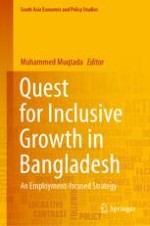2020 | OriginalPaper | Chapter
4. Macroeconomic Policy, Price Stability and Inclusive Growth
Author : Muhammed Muqtada
Published in: Quest for Inclusive Growth in Bangladesh
Publisher: Springer Singapore
Activate our intelligent search to find suitable subject content or patents.
Select sections of text to find matching patents with Artificial Intelligence. powered by
Select sections of text to find additional relevant content using AI-assisted search. powered by
